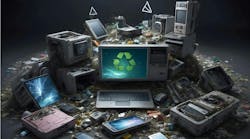Download this article in PDF format.
As a global community, we generate a lot of electronic waste (e-waste). In fact, the United Nations Institute for Training and Research’s (UNITAR) latest Global E-waste Monitor says the escalating e-waste problem vastly outstrips the rate at which we’re recycling those materials. Defined as any discarded product with a plug or battery, e-waste harbors toxic additives and hazardous substances (including mercury) that could threaten human health and environmental well-being.
According to UNITAR, the world is experiencing “significant electronification,” including a digital transformation, with technologies profoundly changing the way we live, work, learn, socialize and do business. This growth has created a surge in the amount of waste from electrical and electronic equipment (EEE) and e-waste. The e-waste generated in 2022 contained 31 billion kilograms (63 billion pounds) of metals, 17 billion kilograms (37 billion pounds) of plastics and 14 billion kilograms (31 billion pounds) of other materials (minerals, glass, composite materials, etc.)
Did You Know?
Here are eight more things to know about the mounting, global e-waste problem:
- The 62 million tons of e-waste generated in 2022 could fill a line of 40-ton trucks encircling the earth’s equator, according to earth.com.
- Just 22.3% of this e-waste was documented to have been recycled properly, spotlighting the vast amount of valuable resources—worth an estimated $62 billion—that remain untapped, and highlighting the increased pollution and health risks to communities across the globe.
- The annual rise of 2.6 million tons in e-waste production—with predictions set to soar to 82 million tons by 2030—"underscores a pressing need to amplify recycling endeavors to prevent further environmental degradation and safeguard human health,” earth.com states.
- Managing e-waste has become big business. DataHorizzon Research says the e-waste management market is on track to reach $207.1 billion by 2032. The market is experiencing a compound annual growth rate (CAGR) of 13.4% right now.
- Disposing of electronic devices carefully is necessary because they contain heavy metals that can harm the nervous system, bloodstream, and vital organs. “Companies invest in e-waste management and recycling systems to achieve zero waste and reduce the use of raw materials in their manufacturing processes,” the research firm states.
- An estimated 19 billion kilograms (42 billion pounds) of e-waste, mainly from metals like iron which is present in high quantities and has high recycling rates in almost all e-waste management routes, were turned into secondary resources, according to UNITAR’s most recent report.
- Platinum-group metals and precious metals were among the most valuable metals but present in much lower quantities; nonetheless, an estimated 300,000 kilograms (661,000 pounds) were turned into secondary resources through formal and informal recycling practices.
- The share of patent applications for e-waste management rose from 148 per million in 2010 to 787 per million in 2022. Most of those applications were related to technologies for cable recycling, “with hardly any signs of an increase in the number of patents filed for technologies related to critical raw materials recovery,” UNITAR reports.
The Pile is Growing
Looking ahead, Statista expects annual, global e-waste generation to hit 82 million metric tons by 2030—up from 62 million in 2022.
“Rapidly advancing technologies, rising consumer demand for electronics, and shorter product life cycles have made e-waste a growing source of environmental concern,” the company reports. “With only 81 countries worldwide covered by electronic waste legislation, policy, and regulation, increasing collection and recycling rates will be one of the biggest challenges of the coming decade.”









